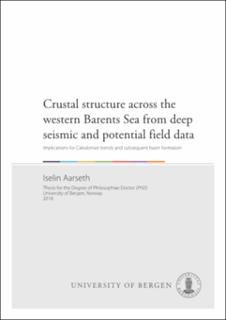| dc.contributor.author | Aarseth, Iselin | |
| dc.date.accessioned | 2018-06-29T13:33:27Z | |
| dc.date.available | 2018-06-29T13:33:27Z | |
| dc.date.issued | 2018-05-24 | |
| dc.identifier.uri | https://hdl.handle.net/1956/17852 | |
| dc.description.abstract | The aim of this project is to map the deep crustal structure of the western Barents Sea in order to increase the understanding of how pre-existing structures related to the Caledonian orogeny and subsequent extensional collapse influenced Palaeozoic rift evolution. Modeling of ocean bottom seismometer data, combined with gravity and magnetic data have been utilized to generate large-scale models along three refraction seismic profiles acquired in 2014. The profiles cross the western Barents Sea with total length of more than 1450 km and include records from a total of 82 receivers. This thesis contains three papers that provide new constraints on the basement and basin configurations in the western Barents Sea. Paper 1 discusses the nature of different basement domains and the eastern limit of the Caledonian suture. The paper presents a P-wave velocity and gravity model along a 650 km long transect. Lateral velocity changes in the crystalline crust are interpreted to represent the Caledonian suture between Laurentia and Barentsia. Additionally, a change in seismic reflectivity indicates a Caledonian suture through the Barents Sea, separating Baltica and Barentsia. Local deepening of Moho creates “root structures” that can be linked to Caledonian compressional deformation or a suture zone. Our model supports the existence of a separate NE-SW Caledonian trend into the central Barents Sea, branching off the N-S trending Svalbard Caledonides, implying the existence of Barentsia as an independent microcontinent between Laurentia and Baltica. Paper 2 investigates Caledonian trends along a profile further south and provides new constraints of the proposed suture zones. Lateral velocity variations in the crystalline crust are interpreted as a transition from Caledonian basement in the west to Timanian basement in the east. Magnetic anomalies correlate well with high velocities and densities in the lower crust beneath Loppa High, suggesting that uppercrustal basement structures may not have significantly affected the magnetic anomaly pattern, and may therefore not necessarily constrain the early post-Caledonian basin formation. Paper 3 discusses the recent (2008-2016) earthquake sequence in Storfjorden south of Svalbard and its possible link to an old zone of weakness within Barentsia. A double magnetic anomaly is observed in the westernmost part of the model, coinciding with the location of a possible high-velocity body modeled in the lower crust. The positive magnetic anomalies are located in the proximity of the Storfjorden earthquake sequence, indicating that compositional and rheological variations in the crust could be related to the seismic activity. The distribution of earthquakes and fault plane solutions suggest the existence of a complex NE-SW oriented fault zone through Storfjorden, and we propose that this zone is linked to the heterogeneous crust in the western part of the model and that it represents old zones of weakness in the crystalline crust, possibly of Caledonian age. Regional and local stresses are most likely related to both thermal and post-glacial uplift that combined with the preexisting zones of weakness in the crust could explain the recent seismic activity. The research presented here provides new constraints on the crustal structure of the western Barents Sea and insights to large scale processes responsible for the post- Caledonian evolution of the Arctic region. | en_US |
| dc.language.iso | eng | eng |
| dc.publisher | The University of Bergen | en_US |
| dc.relation.haspart | Paper 1: Aarseth, I., Mjelde, R., Breivik, A. J., Minakov, A., Faleide, J. I. Flueh, E., Huismans, R. S., Crustal structure and evolution of the Arctic Caledonides: Results from controlled-source seismology. Tectonophysics 718, 9-24 (2017). The article is available in the main thesis. The article is also available at: <a href="https://doi.org/10.1016/j.tecto.2017.04.022" target="blank"> https://doi.org/10.1016/j.tecto.2017.04.022</a> | en_US |
| dc.relation.haspart | Paper 2: Aarseth, I., Mjelde, R., Breivik, A. J., Minakov, A., Faleide, J. I. Flueh, E., Huismans, R. S., Crustal structure across the southwestern Barents Sea: Implications for Caledonian- and basin trends. The article is not available in BORA. | en_US |
| dc.relation.haspart | Paper 3: Aarseth, I., Hauge, B. E., Mjelde, R., Breivik, A. J., Minakov, A., Faleide, J. I. Flueh, E., Huismans, R. S., The Storfjorden earthquake sequence: reactivation of Caledonian zones of weakness? The article is not available in BORA. | en_US |
| dc.title | Crustal structure across the western Barents Sea from deep seismic and potential field data. Implications for Caledonian trends and subsequent basin formation | en_US |
| dc.type | Doctoral thesis | |
| dc.rights.holder | Copyright the author. All rights reserved | en_US |
| dc.identifier.cristin | 1586797 | |
